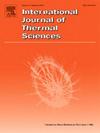Numerical simulation of microwave ablation of lung tumor near the bronchus
IF 4.9
2区 工程技术
Q1 ENGINEERING, MECHANICAL
International Journal of Thermal Sciences
Pub Date : 2025-04-28
DOI:10.1016/j.ijthermalsci.2025.109958
引用次数: 0
Abstract
This paper aims to investigate the key factors affecting the efficacy of microwave ablation (MWA) of lung tumors near the bronchus. A lung anatomical model with three-level bronchial branches was established and a finite element analysis was developed to determine the temperature distribution. The ablation effect under different antenna-bronchial outer wall spacing, air velocity, and tumor diameter was compared and evaluated. The results show that there is a heat sink effect significantly related to the distance of antenna-bronchial outer wall. When the distance increases from 5.0 mm to 12.5 mm, the ablation volume of lung tissue increases by 0.96 cm3, while the air velocity increases from 0.5 m/s to 1.0 m/s, the maximum ablation volume decreases by 0.11 cm3. Tumor size also has a significant effect on MWA. When a 1 cm-diameter tumor is close to the bronchial outer wall, even if we choose the ablation scheme with less energy, which is [40 W, 2 min], the ablation process still penetrates the bronchus. The increase in tumor size leads to the increase of incomplete ablation rate. For 2 cm-diameter tumor, it is necessary to choose the ablation combination with higher energy [50 W, 8 min] or [60 W, 5 min] to avoid inadequate ablation.
微波消融支气管附近肺肿瘤的数值模拟
本文旨在探讨影响微波消融治疗支气管附近肺肿瘤疗效的关键因素。建立了具有三水平支气管分支的肺解剖模型,并进行了有限元分析,确定了温度分布。比较和评价不同天线支气管外壁间距、空气流速和肿瘤直径下的消融效果。结果表明,天线-支气管外壁距离与散热效应显著相关。当距离从5.0 mm增加到12.5 mm时,肺组织的消融体积增加0.96 cm3,而风速从0.5 m/s增加到1.0 m/s时,最大消融体积减少0.11 cm3。肿瘤大小对MWA也有显著影响。当直径为1 cm的肿瘤靠近支气管外壁时,即使我们选择能量较小的消融方案[40 W, 2 min],消融过程仍能穿透支气管。肿瘤大小的增加导致不完全消融率的增加。对于直径为2 cm的肿瘤,需要选择能量较高的[50 W, 8 min]或[60 W, 5 min]联合消融,以避免消融不足。
本文章由计算机程序翻译,如有差异,请以英文原文为准。
求助全文
约1分钟内获得全文
求助全文
来源期刊

International Journal of Thermal Sciences
工程技术-工程:机械
CiteScore
8.10
自引率
11.10%
发文量
531
审稿时长
55 days
期刊介绍:
The International Journal of Thermal Sciences is a journal devoted to the publication of fundamental studies on the physics of transfer processes in general, with an emphasis on thermal aspects and also applied research on various processes, energy systems and the environment. Articles are published in English and French, and are subject to peer review.
The fundamental subjects considered within the scope of the journal are:
* Heat and relevant mass transfer at all scales (nano, micro and macro) and in all types of material (heterogeneous, composites, biological,...) and fluid flow
* Forced, natural or mixed convection in reactive or non-reactive media
* Single or multi–phase fluid flow with or without phase change
* Near–and far–field radiative heat transfer
* Combined modes of heat transfer in complex systems (for example, plasmas, biological, geological,...)
* Multiscale modelling
The applied research topics include:
* Heat exchangers, heat pipes, cooling processes
* Transport phenomena taking place in industrial processes (chemical, food and agricultural, metallurgical, space and aeronautical, automobile industries)
* Nano–and micro–technology for energy, space, biosystems and devices
* Heat transport analysis in advanced systems
* Impact of energy–related processes on environment, and emerging energy systems
The study of thermophysical properties of materials and fluids, thermal measurement techniques, inverse methods, and the developments of experimental methods are within the scope of the International Journal of Thermal Sciences which also covers the modelling, and numerical methods applied to thermal transfer.
 求助内容:
求助内容: 应助结果提醒方式:
应助结果提醒方式:


